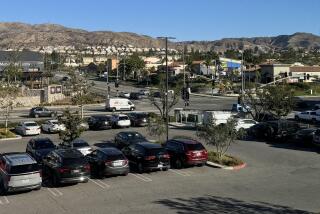Money Crunch Puts School’s Repair in Limbo
- Share via
LA VERNE — Everyone agrees that La Verne Heights Elementary needs fixing--with its small musty classrooms, leaking roof, warped doors, closet-sized offices and uneven playground.
Inspectors found the cafeteria and library to be earthquake hazards, obliging the school to switch both operations to portable buildings.
To allow a major renovation by next fall, the Bonita Unified School District transferred the school’s student body, about 570 children, from the campus in early December.
Two months later, only vandals have altered the site, breaking windows and discharging fire extinguishers on floors and walls of the 55-year-old school.
Now, the entire renovation is in limbo. School district officials--blaming the real estate downturn--say they don’t have enough money to complete the job, estimated to cost at least $1.8 million. Assistant Supt. Karen Willett said the school is structurally safe.
But many parents now worry that their children will have to return next fall to a school that is still outdated and unsafe.
“We just want them to do what they said they were going to do,” said Linda Eubanks. She was among dozens of parents who formed a committee to look into management of the project. The group will report at Wednesday’s school board meeting.
As late as December, the renovation blueprint called for a new cafeteria, new lavatories and expanded office space. It also included air conditioning and earthquake-safe lighting, as well as new cabinets, doors, carpeting, roofing and waterlines.
The board canceled the cafeteria Dec. 19, even though construction bids came in at expected amounts. The problem was a decline in anticipated developer fees related to a regional lag in real estate sales, Willett said.
The district expected to receive $150,000 in fees from La Verne developers this fiscal year. At the end of the first quarter Sept. 30, the district had received less than $27,000, and home building since has declined, Willett said. The district had hoped for about $500,000 in developer fees next year. “That may not happen now,” she said.
Unforeseen costs also threaten to pare away remaining elements of the project. The district will have to spend thousands of dollars to upgrade the school’s fire safety and handicapped access, including installation of a lift for the auditorium stage.
Removal of potentially cancer-causing asbestos could increase costs further. The building’s floor tiles and pipe insulation contain asbestos. Up to now, inspectors judge there is little risk for students, said Fred Arambula, director of facilities. The district has not assessed, however, whether a major renovation would release asbestos into the air, triggering expensive abatement procedures.
The renovation will be primarily funded by a $7 million district bond issue approved in 1989. That bond also was to pay for a new school in north La Verne and to air condition district schools as needed. The new school--where the La Verne Heights pupils temporarily attend classes--has cost about $5.25 million, more than estimated.
Much of the air-conditioning work has been postponed, and the board placed a $1.1 million ceiling on the La Verne Heights project, meaning only part of the work can be done, Willett said.
Now, the district is investigating prospects for a new bond issue of more than $30 million, said Supt. Duane Dishno.
In the meantime, the school board on Wednesday will consider three options for La Verne Heights: a scaled-back modernization; closing the school, or tearing down much of the school and installing more portable buildings.
Some parents say tearing down the quaint, red-brick school would deprive the community of a historic landmark. La Verne Heights is the district’s oldest school and is on the site of the first school in the La Verne-San Dimas area.
Willett said closing the campus could create crowding at other schools. Developers are still laying out housing tracts in this largely middle- and upper-income community at the east end of the Foothill Freeway.
Leaving the unnamed new school to go back to a little-improved La Verne Heights would be hard for many pupils, Eubanks said. “How’d you like to be driving a Cadillac,” she said, “and then given a Volkswagen and be told, ‘This is what you’re going to be driving.’ ”
More to Read
Sign up for Essential California
The most important California stories and recommendations in your inbox every morning.
You may occasionally receive promotional content from the Los Angeles Times.











